|
Thursday, Oct. 3
- Breakfast: Canadian bacon, egg and cheese Texas toast
- Breakfast: sausage gravy omelet
- Chopped-pork barbecue sandwich
- Smart cuisine: finger-lickin' baked chicken
- Mom's meatloaf
- Spicy buffalo chicken wrap
- Greek chicken salad
- Chef's choice soup
- Italian wedding soup
- Assorted pizza by the slice
Wilson Hall Cafe menu |
|
Friday, Oct. 4
Dinner
Closed
Saturday, Oct. 5
Dinner
- Beet, cabbage and mushroom borscht
- Phyllo-wrapped beef croustades
- Baby spinach with scallions and lemon
- Coffee ice cream with Baileys Irish cream
Wednesday, Oct. 9
Lunch
- Roasted vegetables and goat cheese on herbed focaccia
- Grilled shrimp and wild rice medley
- Lemon almond butter cake
Chez Leon menu
Call x3524 to make your reservation.
|
|
Nobel predictions favor Higgs pioneers
 |
| Two physicists who helped shape Higgs theory should expect a call from the Swedish Academy next week, says a media firm famous for its Nobel predictions. Image: Sandbox Studio |
Speculators have begun to wonder, in the days leading up to the announcement of the 2013 Nobel Prize for physics, whether the Swedish Academy will recognize the most celebrated particle physics discovery of 2012: the Higgs boson.
Media and information firm Thomson Reuters recently intensified the buzz by predicting that Francois Englert, a Belgian physicist associated with Université Libre de Bruxelles and Chapman University in California, and Peter Higgs, a British physicist associated with the University of Edinburgh, will receive the honors this year. Both scientists helped develop the theory of the famed boson.
The Higgs boson is a particle associated with the Higgs field, an essential component of our universe that gives mass to elementary particles. Theorists first predicted the existence of the particle and field in 1964, and two large, international teams of scientists working on experiments at the Large Hadron Collider finally announced its discovery on July 4, 2012. Nearly 2,000 scientists from the United States helped make the discovery at the LHC happen.
Thomson Reuters studies citations of individuals' research to determine likely Nobel winners, a technique that has resulted in 27 successful predictions in a dozen years, including seven for physics. In 2012, a representative of the firm rejected the idea of a Higgs-related win, arguing that the discovery took place too late in the year to be recognized through the prize.
This year, however, Thomson Reuters is all in, mentioning Englert and Higgs at the top of their 2013 Nobel-predictions press release.
Read more
—Kathryn Jepsen
|
Across the lines
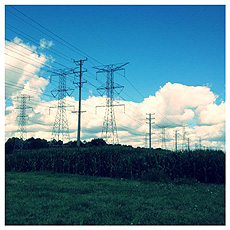 |
| The power lines over Fermilab converge with rows of corn. Photo: Sarah Witman, DO |
|
Fermilab Arts Series presents Quebec trio De Temps Antan – Saturday, Oct. 5
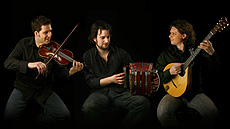 |
| De Temps Antan perform traditional melodies with a contemporary twist on Saturday in Ramsey Auditorium. |
It takes a special blend of musical flair to create memorable songs of yesteryear, pieces with a hint of contemporary that still speak to familiar rhythms of the past. Welcome to the original musical stylings of De Temps Antan.
All the way from Quebec, the trio De Temps Antan performs as part of the Fermilab Arts Series on Saturday, Oct. 5, at 8 p.m. in Ramsey Auditorium.
Since 2003, Eric Beaudry, Andre Brunet and Pierre-Luc Dupuis have been exploring and performing time-honored melodies from Quebec's musical past. Using fiddle, accordion, harmonica, guitar, bouzouki and a number of other instruments, the three virtuosos blend boundless energy with the unmistakable joie de vivre found only in traditional Quebec music.
The group's percussive footwork keeps a lively beat throughout the songs and instrumentals, and the folk harmonies and textures will keep the audience engaged all the way to curtain call.
Tickets are $22, $11 for those ages 18 and under. The Fermilab Box Office is relocating this week, so the best way to purchase tickets is online or by calling 630-840-2787. Chez Leon will also be open Saturday evening at 6 p.m. To make dinner reservations, call 630-840-3524.
|
Invigorated and unified, U.S. particle physics community considers future directions
From Physics Today, October 2013
"The Higgs boson changes everything. We're obligated to understand it using all tools," Michigan State University experimentalist Chip Brock said in his wrap-up talk at "Snowmass on the Mississippi." Nearly 700 high-energy physicists, mostly from the US, gathered at the University of Minnesota for nine days in late July and early August to take stock of their field.
Snowmass wasn't all about the Higgs, though. For example, the third mixing angle for neutrinos, θ13, was recently measured to be larger than expected, which set the stage for further investigation. Another big question is why the universe has more matter than antimatter. And University of Chicago physicist Jonathan Rosner notes that "the elephant in the room is dark matter. There's five times more of it than us, and we don't know what it is. We have a lot of unanswered questions. It's not time to close the books and go home." Rosner coordinated Snowmass in his role as chair of the American Physical Society's division of particles and fields, the organizing body.
Read more
|
|
Finding hadrons inside jets
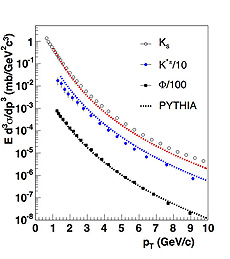 |
| The figure shows the inclusive invariant pT differential cross section distributions
for Ks, K*± and φ measured in this experiment. The predictions from PYTHIA are shown as dotted lines. |
Physicists currently have a very good understanding of the Standard Model. Thus many of the results presented in this column can be understood in terms of the Standard Model theory of the strong interactions, called quantum chromodynamics. But the particle production from soft interactions — collisions usually referred to as minimum-bias (MB) events, in which outgoing particles scatter only minimally, and which dominated the cross section at the Tevatron — cannot be calculated from first principles. Neither can jets, which are the production of particles from high-energy quarks or gluons. Scientists have therefore developed phenomenological models, such as PYTHIA, by tuning to the data.
One goal of this analysis is to provide detailed particle production information at a center-of-mass energy of 1.96 TeV to refine current phenomenological models.
CDF physicists have looked at the rate of production of hadrons, strongly interacting particles, that contain a strange quark in MB events. The three particles we look for are Kshort (Ks), K*±(892) and φ(1020). The top plot shows that the φ cross section matches well with PYTHIA, that the Ks is a little lower than the data, and that K*± is a little higher than the data.
CDF scientists have also studied the transverse-momentum distributions of identified hadrons produced in jets. This is the first time scientists have measured this distribution. The hadrons we look for are the Ks and the Λ.
The lower figure shows a highlight of this analysis. Plotted is the ratio of the Λ hadron production cross section to Ks meson production as a function of the transverse momentum (pT) from MB events (top two plots) and jets (lower five plots). The top curve is taken from Fermilab E735, an early Tevatron collider experiment, and the second curve is taken from this experiment and from an earlier version of this experiment.
The ratios from MB events exhibit an excess production of Λ hyperons around 2
GeV/c pT. The results from jets are according to the transverse energy (ET) of jets. Unlike the ratios from MB events, the ratios from jets are fairly constant, hovering at approximately 0.25 for all transverse momenta. This implies that the process of producing Ks and Λ's
in jets is similar for all transverse momenta. Another interesting result is that the ratio from MB events merges with the ratios from jets as the transverse momentum increases. This could indicate that the particles above about 5 GeV/c in MB events are likely from soft jets.
Learn more
—edited by Andy Beretvas
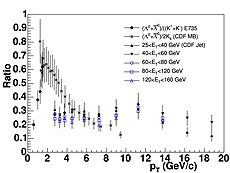 |
| The cross-section ratios of Λ0 baryon to strange meson as a function of pT.
The statistical and systematic uncertainties are added in quadrature.
|
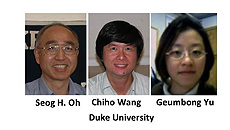 |
| These CDF physicists contributed to this data analysis. |
|
Muon g-2 ring move featured on Discovery Channel's "The Daily Planet"
The Discovery Channel show "The Daily Planet" sent a film crew to follow the move of the Muon g-2 electromagnet this summer. The filmmakers tracked the move from the dock in Lemont, Ill., to the laboratory and were at Fermilab for the July 26 arrival party. The resulting segment aired on Discovery Channel Canada on Tuesday and is available to view online.
|
|